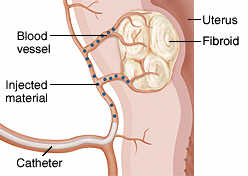Uterine Artery Embolization
Uterine Artery Embolization (UAE) or Uterine Fibroid Embolization (UFE) has proven successful in significantly decreasing or eliminating fibroid related symptoms of bleeding, pressure and pain in the majority of the thousands of women with large or multiple uterine fibroids. Uterine Fibroid Embolization is a minimally-invasive alternative to surgery used to treat women who are having symptoms from fibroids.
Procedure
This procedure is performed by an interventional radiologist. Before treatment you are given a sedative and pain medication to help you relax. You lie on a patient table and are made comfortable before starting treatment. The treatment takes place with you lying on the patient table inside the MR scanner. Your clinical team will be in the next room with two-way communication using a microphone and a speaker. The doctor will inform you when images are being acquired (scanning) and when the system is sonicating (treatment).
It begins with a tiny nick done in the groin area. This nick provides the IR with access to the femoral artery in the upper thigh. Using specialized X-ray equipment, the IR passes a catheter (small tube) into the femoral artery, to the uterine artery, and guides it near the location of the fibroid tumor.





